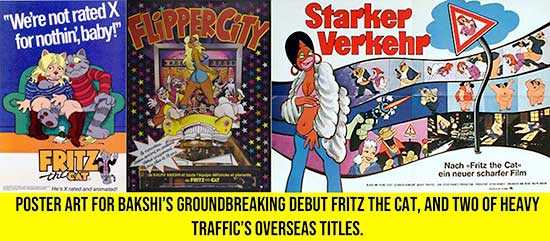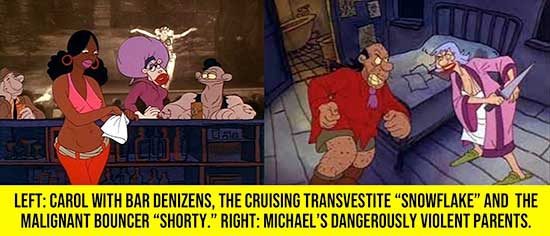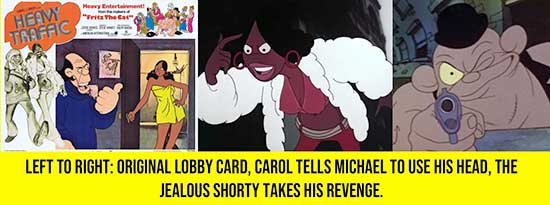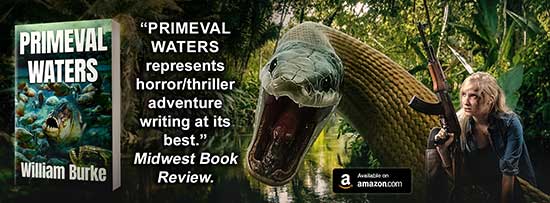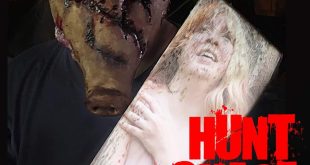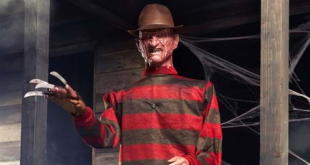SYNOPSIS:
In this adult animated feature, aspiring cartoonist Michael falls in love with Carol, an African American bartender. The couple struggle to escape their hellish urban environment, but fate isn’t on their side.
REVIEW:
The seventies represented a golden decade for filmmaking, spawning some of the most important and personal works ever committed to celluloid. Taxi Driver, The Exorcist, Star Wars, El Topo and A Clockwork Orange represent a smattering of the greatness created by a vanguard of auteur filmmakers. On the downside, the seventies also gave us Zabriskie Point (1970) and Zardoz (1974) so unsupervised auteurism isn’t an exact science.
Animation pioneer Ralph Bakshi is one of that era’s unsung heroes. That outsider status is self-inflicted, as he’s the very definition of a hit or miss filmmaker. His career spanned creative high points like Fritz the Cat (1972), and Lord of the Rings (1978) along with the equally praised and reviled Coonskin (1975). But there were also noble misfires like Fire and Ice (1983) along with train wrecks like Cool World (1992).
Heavy Traffic represents his most deeply personal work, offering a glimpse into both his troubled childhood and unfettered Id. It’s a dark, visually stunning piece of animation that deserves to be seen. Consider it Ralph Bakshi’s 8 ½.
Prior to Heavy Traffic Bakshi had spent years creating children’s animation for Terrytoons, while nurturing a dream that animation could be used to tell visually striking adult stories. That opportunity came in 1972, when he wrote and directed the big screen adaptation of Robert Crumb’s underground comic Fritz the Cat. Fritz’s radical depictions of drugs, sex and race got it slapped with an X-Rating, which should have been box office poison. But veteran exploitation distributor Jerry Gross (I Drink Your Blood 1970, Zombie 1979) chose to wear that dreaded MPAA rating like a crown, proclaiming, ‘We’re not rated X for nothin’, baby!” It worked.
Fritz’s creator Robert Crumb loathed the film, but audiences flocked to it, resulting in a fifty-million-dollar gross. The success led to a sequel The Nine Lives of Fritz the Cat (1974) produced without Bakshi’s involvement. Now a bankable director, Bakshi was given creative carte blanche for his next project, the autobiographical Heavy Traffic.
The film’s lead character Michael, a barely disguised version of Bakshi, lives in a Brooklyn neighborhood that would make Taxi Driver’s Travis Bickle squeamish. Michael’s knife wielding Jewish mother and philandering, mobbed up Italian father reduce his homelife to a living hell. Things aren’t any rosier outside. There’s a parade of psychotic drunks, mobsters and hookers along with a local street gang that’s so violent they resort to knifing each other when no other victims are available.
Michael’s escapes his grim reality by watching movies and flirting with Carol, an African American barmaid who gives him free beer in return for cartoons. The two strike up a relationship, vowing to escape their urban hellscape. In most Hollywood films this would lead to love triumphing over all obstacles. But Bakshi ignores that convention, sending the couple into a disturbing downward spiral. But here’s the big question—are we watching the actual events transpire, or are we witnessing Michael’s imagination playing out on screen? The answer is… watch the movie and make your own decision.
Heavy Traffic owes much to Hubert Selby Jr’s seminal 1964 novel, Last Exit to Brooklyn, particularly in Traffic’s cruising transvestite character, Snowflake. Like Selby’s novel, Heavy Traffic has been criticized for its lack of sympathetic characters. Our hero, Michael, starts out likeable enough, but gradually descends into a misogynistic monster, while Carol seems all too comfortable violently victimizing the men who desire her. Michael’s mother continuously attempts to murder his father. That father is so racist that he puts a mob hit out on his own son for sleeping with a black woman. This all sounds horrifying, but Bakshi injects enough humor into this dark void to keep viewers enthralled.
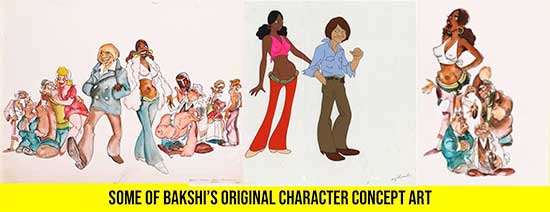
While the story is compelling, it’s the visuals that make Heavy Traffic so memorable. Bakshi is truly the Walt Disney of squalor, and his ground breaking meld of animation, live action and photographs still holds up today. The opening ten minutes is an eye-popping visual tour de force deserving multiple rewinds. Bakshi’s background art and character designs are ferocious, unrestrained and distinctly his own.
But be warned—Heavy Traffic contains broad racial and ethnic portrayals that could (and likely will) offend sensitive viewers. Bakshi’s films have always been racially charged, particularly his vicious satire of Disney’s Song of the South entitled Coonskin. Many critics condemned Coonskin as racist, while comedian Richard Pryor called it one of his favorite films. I’ve never felt that Bakshi was a racist, but rather a genuinely subversive filmmaker who attacks bigotry by shining a spotlight on society’s ugliness. Heavy Traffic also contains violence and nudity, but if you find any of its sexuality arousing you should probably seek professional help.
This film has always been a bit of a shaggy dog in terms of audiences. It performed well on its original release, despite alienating viewers expecting another bawdy comedy like Fritz the Cat. The late seventies and eighties midnight movie craze made it ripe for rediscovery along with Rocky Horror, Eraserhead and Pink Flamingos. But, while Heavy Traffic could certainly pack New York’s Waverly Theater (ground zero for midnight movies), it was too unrelentingly bleak for middle America, where “Doing the Time Warp,” was still considered outré.
Overall, Heavy Traffic is a unique, thought provoking piece of cinema that could only have been created in the seventies by Ralph Bakshi. In our modern world of computerized animation, it’s a revelation to see a film painted from a single artist’s brush and psyche. It’s a film you should see. And, like Jodorowsky’s El Topo, even if it offends and enrages you, you’ll still find yourself talking about it incessantly.
And for some more traditional thrills and chills check out my novel PRIMEVAL WATERS, published by Severed Press. It’s available on Amazon.
 Horror News | HNN Official Site | Horror Movies,Trailers, Reviews
Horror News | HNN Official Site | Horror Movies,Trailers, Reviews

